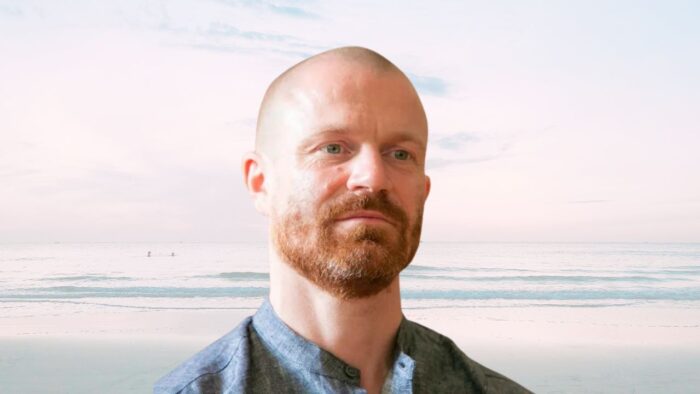Belgium-based Teune van der Wildt may have discovered yoga by accident but his decision to pursue the spiritual path was done with intent and purpose. He started practising Ashtanga Yoga in his 20s and since, he has explored various aspects of spirituality and his passion for Indian knowledge systems inspired him to have an integrated approach to his yoga practice. In addition to Ashtanga Yoga which he studies at the Sharath Yoga Centre in Mysore, he is also a chanting teacher and has studied Vedic chanting with Shantala Sriramiahji. Teune talks to Indica Yoga about his spiritual inspirations and his love for all things India.
Sophia: How did you discover Ashtanga yoga?
Teune: Like many people, I accidentally walked into a class. It immediately sparked my interest, seeing people (mostly older ladies, while I was a guy in my twenties) putting their bodies through all kinds of crazy yoga shapes. What drew me is that you are really challenged to use your body's capacities without being competitive, and with an inward focus. It seemed to me that this practice could be healing for the body and calming for the mind. At that moment I knew that I wanted to invest time on this and explore what I could do with my body. Almost like a moment of recognition of a long past memory.
Sophia: You attended a Vedic chanting course with Shantala Sriramaiahji, what drew you to chanting?
Teune: Chanting was always present in my early yoga experience. Of course, when practising Ashtanga, each āsana session is opened and closed with a few mantras. However, in my early phase there wasn’t a steady Ashtanga programme where I lived at the time, so I ended up practising a lot instead at a Jivamukti-inspired studio. This style of yoga takes elements from Ashtanga āsana sequences and is infused with music by Western devotees of Neem Karoli Baba. We chanted simple mantras as well as the Hanuman Chalisa. I also practised a lot with a vinyāsa-flow teacher who was strongly influenced by the Hare Krishna movement (ISKCON), so chanting was always part of my yoga experience.
Coming from a non-religious and non-musical background, chanting was foreign and exotic to me. Nevertheless, its soothing effects intrigued me. Still, the musical aspect was not really my cup of tea. I was mostly interested in the meditative effect and the underlying philosophy and science. On my first trip to India, I did briefly try to improve my musical skill by going to a harmonium teacher. There I quickly realised that Carnatic Music is an entire Yoga system in itself, a lifelong sādhana complete with guru paramparā, underpinned by a deep understanding of sound and the working of consciousness, and devotion to the divine. I was so impressed by this teacher and instantly realised that I didn’t want to continue to waste his or my own time by trying to learn music. Not in this lifetime at least! On that same trip to India, I had come to practice āsana under guru Sharath Jois, and I was introduced to chanting of Vedic mantras as well as various stotrams by Lakshmisha Bhat, the Sanskrit and philosophy teacher at KPJAYI/SYC. I resonated a lot with his teaching and the sound of Vedic chanting really sparked my interest. Although mysterious, there was a feeling of recognition with Vedic chanting that was similar to the feeling I had when I took my first Ashtanga āsana class.
Years later, I was lucky to meet Shantala SriramaiahJi, who is now my principal teacher. Her teaching is extremely lucid and accessible to international audiences. She is firmly grounded in her own sādhana and connected to a solid lineage, both from her family as well as her main guruji, M.S. Sreenivasan of the Challakere brothers. I feel extremely blessed to be able to learn from her.
Sophia: How has chanting affected your Ashtanga practice?
Teune: Certainly, when we do lots of intense āsana while sweating, there is a lot of energy awakened and accumulated in the body. When we don’t engage in devotional practices such as chanting, ritual or selfless service to others, this energy will not be channelled properly and can create great physical, mental and emotional unrest. I can attest to that because I am learning devotion at a later point in my life, and it has been a long journey of trial and error trying to incorporate devotion into my daily rhythm. Devotion is basically keeping your mind on a larger reality, the Divine. Chanting simple mantras at first, even with music, is great for releasing energy and balancing emotions. However, just as there is progress in āsana when your posture becomes more grounded and easeful, there can be advancing in chanting for those who are drawn to it. When trying to keep svara (the three notes of Vedic chanting), concentration is of such level that you actually feel as if neural pathways are being built or restored! Your ability to stay focused, your capacity to remember, for example will vastly improve, even at an older age. I notice that the stimulation of these mental faculties helps me in making choices in life, having less doubt and mental affliction. Āsana alone can strengthen desires and trick the ego, but chanting practice is helping me find clarity by moving beyond my physical capacities. I feel that chanting facilitates the realisation of one’s true and unique role in this existence, shining light on svadharma. Simply by going out of one’s own habitual mindspace of likes and dislikes, and literally tuning into a higher vibration.
Sophia: Is there any mantra or verse you feel deeply connected to and why?
Teune: Honestly, each time I learn a new mantra, I feel especially connected to it. This shows how the mind operates; that which you put your attention to, will fill your mind and heart. Therefore I’m so grateful to be guided by an excellent teacher, ShantalaJi, who carefully selects the mantras after meticulously learning them from her guru, and presents them to her students by means of live classes as well as material for self-study. Since this month we have Maha Śivarātri, I would like to share that when learning Rudram, I really experienced what it may be like to have unhelpful karma reversed. Reversing karma is the theme of this Veda composition, and it is actually the learning process of the chanting that transforms a dull and distracted mind into a single-pointed one. Following the traditional method of keeping correct pronunciation, intonation, fluentness, etc., the mind is becoming aware of each distraction. Being aware starts the transformation of these unhelpful mind patterns into helpful ones. It really is that simple. Through concentration, vices can automatically be replaced with virtues.
Sophia: How do you incorporate chanting into teaching Ashtanga?
Teune: Last week, I just finished teaching the chanting of the Samādhi Pādaḥ with students, the first chapter of the Yoga Sūtra’s of Patañjali. I look forward to building further on that. Soon, I will also offer some mantra japa for our Ashtanga community here in Antwerp. After finishing the current teacher training with ShantalaJi, I look forward to diving a bit deeper into my own practice before I would teach any longer Veda mantras.
Sophia: What is your spiritual purpose?
Teune: To live a life without inner conflict. To experience no difference between my thoughts, my words and my actions. This definition of samadhi, enlightenment, is really what we all are searching for, isn’t it? To choose all my actions with full conviction and embrace the life that I’m going through fully, and not being averse to any aspect of it.
Sophia: Any advice for young students who want to teach Ashtanga and chanting?
Teune: When it comes to teaching, it really is essential to give priority to one’s own sādhana. You need time and energy for your own practice, and teaching can only come from what you know first-hand. Always keep learning and remain connected to teachers who come from a lineage (paramparā). And some good advice if you are considering teaching; don’t be financially dependent on it.
Sophia: What does India mean to you?
Teune: India is the motherland of yoga and of universal spirituality. This is the only culture which has maintained uninterrupted practices, rituals and traditions since time immemorial. Therefore, the connection with ancient knowledge is very much alive, and even today great people from these traditions tend to share their wisdom with the world generously. In India, divinity is tangible and I have experienced wonderful hospitality. The hard-working yet cheerful nature of people makes it that I have learned great life lessons, even from rickshaw drivers.
For further information on Tuene’s work, please access his webiste.





